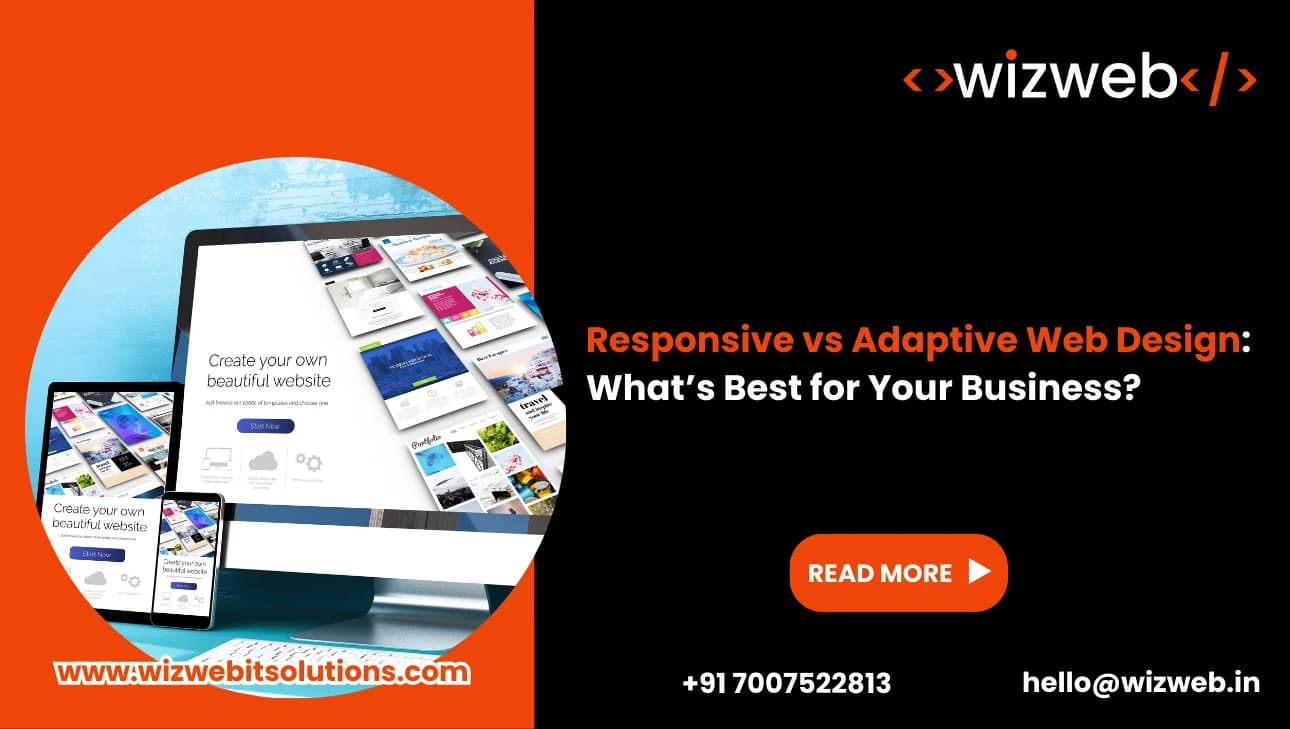Get in Touch
- Phone
+91 700 752 2813
- Email Now
hello@wizweb.in
Office No - 204 A-140, Sector 63 Road Noida, Uttar Pradesh 201301

When you plan to build or upgrade your website, one of the biggest decisions is choosing between Responsive vs Adaptive Web Design. These two terms are often confused, but they are not the same. If you own a business and want your website to look great on all devices, understanding the difference between Responsive vs Adaptive Web Design is very important.
In this blog, we’ll break everything down in simple words, so by the end, you will know exactly which approach fits your business.
Responsive Web Design means your website layout automatically changes its shape and size based on the screen it’s being viewed on. It’s like water in a bottle — it takes the shape of the container. Whether someone is viewing your site on a big desktop monitor, a tablet, or a small mobile phone, the content smoothly adjusts itself.
This is done using flexible grids and media queries in CSS. So, the same website code is used everywhere, but it stretches, shrinks, or rearranges based on screen size.
For example, a three-column layout on a desktop might become a single column on a mobile phone. Everything simply “responds” to the screen.
On the other hand, Adaptive Web Design works differently. It detects the device first (using breakpoints) and then loads a specific layout designed for that screen size.
Think of it like a tailor-made suit. You prepare different suits for different body types. Similarly, with adaptive design, you might have separate layouts designed for mobile, tablet, and desktop. The website picks the right one to display.
For example, when someone visits your site from a smartphone, it serves a version specifically designed for small screens. This makes it highly optimized for that device.
When comparing Responsive vs Adaptive Web Design, here are the key points:
| Feature | Responsive Design | Adaptive Design |
| Layout Changes | Fluid and flexible, changes with any screen size | Fixed layouts designed for specific screen sizes |
| Development | One site fits all screens | Multiple layouts designed for different devices |
| Maintenance | Easier to maintain (single design) | More complex, as each layout might need updates |
| Load Time | Sometimes slower on mobile due to loading all content | Can be faster as it loads only what’s needed |
| Future Devices | Automatically adapts to new screen sizes | May not be optimized unless a layout is added |
Now comes the big question — Responsive vs Adaptive Web Design: What’s best for your business?
Choose Responsive Web Design if:
Choose Adaptive Web Design if:
Deciding between Responsive vs Adaptive Web Design is not just a technical choice — it impacts your entire business. A good web design ensures customers stay on your site longer, explore your products or services, and trust your brand.
This is why it’s smart to work with professional web Design Services. Experts can study your audience, your goals, and your existing website traffic to recommend what’s best. They can also ensure that whichever option you pick is implemented beautifully and works flawlessly.
In the end, the debate of Responsive vs Adaptive Web Design comes down to your business goals, audience behavior, and budget. If you want a flexible, future-proof site that looks great everywhere, go responsive. If you need a site finely tuned for different devices with maximum speed and control, adaptive might be better.
No matter what, partnering with quality web Design Services can make sure your website not only looks stunning but also helps your business grow.